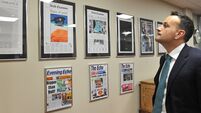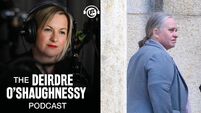Find a friend: One care home boy's tireless search for a fellow resident

Nazareth House: A 'pauper's refuge' for children and older people in Sligo town in the 1960s and 1970s.
'My name is Sean…’ began the stranger’s email which popped into my inbox last April. It ended with ‘Could you help me find her?’ I hit reply.
Sean* was a ‘home boy’, reared by the nuns and staff of Nazareth House care home — often dubbed a pauper’s refuge — for children and older people in Sligo town in the 1960s and 1970s.
He still remembers the day his mother left him there at the age of five, lots of children around a long table, and the special tray of tea and china Sr Fintan would lay out for his mother when she came to see him. He was boarded out to a farmer briefly, sent to an institution in Galway, then returned to Nazareth until he was 14, whereupon he moved to Munster with his mother. He is an only child.
Sean settled down, married, had children of his own, tragically lost a child. Now in his late 50s and a grandfather, his parents both deceased, his childhood still haunts him. He wants to reconnect with someone who shared his past, a girl we shall call Angela, but his search yielded nothing. She wasn’t on social media. He then found previous articles online I had written about former Nazareth care home residents and reached out.
After a couple of days of fruitless searching online myself, I turned to Sr John, archivist and special information officer at Nazareth House. She has been curating records on the 1,915 children who spent time in the home between 1910 and 1993 for almost 30 years.
Now in her 80s and frail after a few falls, Sr John is nonetheless determined to finish her work.
“I’m passionate about it. I have about a hundred left to do,” she tells me over tea in the little visitors’ room at Nazareth House. I wonder was this where Sean’s mother sat 50 years ago.
“It’s been an ongoing process since the Residential Redress Board — the floodgates opened then,” she says. The flood of inquiries has since slowed down to a constant ‘dribble’ over the decades since.
“You’re giving them knowledge really, because you can’t rewrite history. Then at least they know. I always feel that everybody is entitled to know where they belong, their bloodline if they can get it,” she says. She remembers both Angela and Sean. She agrees to write to whatever address she has for Angela on his behalf.
Sr John was our biggest hope of finding Angela because there are no formalised networks for past residents of care homes to trace each other in Ireland or the UK. The old informal networks of voluntary church workers and the likes of the Legion of Mary have all broken down and don’t exist in the local parish form they used to, which might have helped peers trace each other.

The recently passed Birth Information and Tracing Act will allow adopted people and their biological parents guaranteed access to information and records about their birth and early life, but there is currently no facility for peer tracing.
“The system is geared up to block that happening,” says author, historian, and former social worker Michael Murphy. He has spent years managing child protection and institutional abuse investigations in England. Many of his clients were former residents of Irish religious institutions.
“The barriers are tremendous for anybody attempting to make such contact because of privacy. The access to information, even about your full-blood siblings, is difficult. The authorities can’t just give information out and the problem is even greater for former care home residents,” he says.
Peer tracing is crucial in helping people round out their often distorted memories and perceptions of childhood, Murphy believes. He cites the example of one former resident who used to return to Nazareth to meet the yard man and the cook and reconnect with them. “’They were the only family I had,’ was the phrase he used. He drew support from that contact with the people who knew him as a child and weren’t the direct authority figures,” he says.
Murphy describes a ‘memory reservoir’ that people like Sean are trying to fill with two things: “Information to fill in the gaps of what life was like for them but also the reconstruction of their care family.”
When those older care homes figures are not there, reconnecting with peers can help in that process, the people with shared childhoods.
In Murphy’s view, there should be a duty on the State, which should be responsible for people like Sean, to create “information contact networks”, not social media, where people, subject to relevant safeguards, can find a way to trace each other. “That would do a tremendous amount of good for the psychological wellbeing of people who were there because they would be revisiting, like you would with old school friends, and help them share,” he says.
Childhood bonds are lifelong bonds that shape us, according to Ian O'Grady, a past president of the Psychological Society of Ireland and himself a former resident of St Patrick’s Guild. “People will desire connection. If residents are in an institution and they grow up with people there, they form bonds. It’s very understandable from a psychological point of view why they would go looking for these people, similar to why people look up old school friends on Facebook.
"The people around them in their formative years, they’re as close as siblings, I’m guessing. I think the difficulty that they’re going to face is that there’s a wall of silence around a lot of these things which is maybe understandable for families. Unfortunately, in Ireland there’s a shame and a stigma about this,” he says.
Like Murphy, O’Grady believes the adoptive register about to be launched next month should include a facility for safe peer tracing. “There should be some facility where former residents can also indicate that they would like to meet other residents. There’s a huge amount of sense in putting something like that together where people have a choice of opting in or not.
Several weeks pass and we hear nothing back from Angela. Sean travels up to Sligo to hand in a letter he wrote himself to Sr John to post to Angela, which she again agrees to send, despite our joint fears she may have moved.
I decide to approach Tuam historian and mother and baby homes activist Catherine Corless. She jumps into the search with gusto and digs into Angela’s home county, turning up vital pieces of historical information on her ancestors. “The way I search for people is I’ll always work backwards first of all, on the generation before and maybe back to grandparents because you can work forward then,” she tells me from her home in Tuam, Co Galway.
On Irishgenealogy.ie, birth certs only go as far as 1921. Marriages go up to 1947 and deaths are recorded up to 1970. The census of 1911 is useful also. But what Corless finds most useful is the Irish newspapers online archive. “They were very good at reporting in the earlier decades, say the 1930s, '40s, and ‘50s, especially court cases. It could be very trivial things like car tax but you will get a name and a place so that’s really helpful. I intertwine them all and eventually you get the information,” she says.
Corless, a tireless researcher as well as campaigner, gets calls all the time from people trying to trace parents, sometimes four or five different people at the same time, but Sean was the first time she was asked to help find a friend. It usually takes just a few weeks for Corless to turn up a blood relative. “I find a fair bit of information for people and if I can’t get it all, it gets them halfway there,” she says.
“I’d find the mother’s grave for them alright and they’re satisfied with that if the mother did pass on, just to have the grave to visit.”
Unlike other former care homes, an informal network of past residents sprang up in Tuam in the aftermath of the babies' burial ground scandal. It has been a therapy for them, says Corless. Former residents have gradually been able to openly admit they lived in that home by meeting at her house over a cup of tea.
“There’s a few groups, some of them have broken up and gone their own way or gone to other groups, but as regards myself, I was just there for everyone. All I did was bring the survivors together and they formed their own groups. I brought them together because they were anxious to give their story and that turned into documentaries being made and they were always willing to speak on documentaries. We’d always meet here at my house, I facilitated that because I was so delighted to help them in coming forward,” she tells me.
Has Corless got any advice for someone thinking of tracing a former care home resident?
“Facebook. You go there and you see who’s online, quite a lot of older people, especially people abroad. There are different groups online, adoption groups online that you can contact and they do a bit of research for you. Put the message out there, put a letter in the paper or something. It’s amazing, when people come to this age, they like to make contact again,” she says.
Like others, Corless would be supportive of a formal peer-tracing facility being set up. “I could see that happening, that people would be interested in joining a network. Maybe they feel that there isn’t a hope yet,” she says.
Armed with the new information from Corless’ search, we keep searching for other clues online, until bingo, one day Sean comes across a photo online. He thinks it’s Angela. I think he might be right. I act on the hunch and approach a third party. They agree to put me in touch with Angela. The days go by and still we wait. Nothing happens. We have to accept Angela may just not want to be found.
“What you need to consider for the people being contacted,” says O’Grady, “is that whilst repressing issues is not the most beneficial psychological strategy in the long term, many people will have done that.
“Many people will have experienced abuses there and will not want a call from the blue, albeit from someone that they liked and cared for. But if it’s a reminder of where they were, people may struggle being brought back into that aspect of their childhood that they spent a lot of years looking to overcome and forget about."
This is the risky side of tracing a long-lost friend. This is where the aforementioned two-sided opt-in with the new birth information register would “make sense”, according to O’Grady, both in terms of people feeling safe and vis-a-vis the people who want to connect.
“You always have to worry about the idealised versus the reality. If a lot of hopes are pinned on meeting people who would have shared this care home experience in childhood and think ‘it’s going to give me meaning’ or ‘that’s going to give me purpose’, it may, but it may not,” says O’Grady.
Anyone coming to see him about prospectively contacting either a biological parent or non-biological sibling or a child who shared an experience with them in a care home is urged to consider all of the eventualities prior to doing it and then if it still feels like a good idea, to go ahead but accept the challenges that will come up afterwards.
He says former residents could be in “very different places". “It can be very hard to understand why someone wouldn’t want to meet yet they might have very valid reasons. That’s where an intermediary makes total sense,” he says.
“There certainly should be some scheme similar to the adoption register where they will have a thought-out stage process where people can think about do they want to flag themselves as wanting to be told; if yes, do they want someone to contact them, what kind of contact do they want that to be, etc."
The rights of people who don’t want to be contacted needs to be represented also, he warns. “What’s really tricky from a psychological point as regards the situation you describe is neither of those children wanted to be in the situation they were in. But the choices that they’ve made since they were 18 may have moved them further away from those memories or closer. They need a choice around how that pre-18 information is shared and accessed because that choice was denied to them before the age of 18.
“Hello Sorcha,” begins the stranger’s email which pops into my inbox on 21 August. It’s her. I quickly send on phone numbers and wait. Several hours later, my phone rings with a number from the other side of the world and my heart jumps out of my chest. “This is Angela,” says a soft voice.
She left Ireland decades ago, built a new life abroad, got counselling in her twenties— “best thing I ever did”. She readily admits she would not want to be part of any former residents group. Nazareth House is now “water under the bridge”. She remembers Sean and I pass on his number. Later that night, I get an excited text from Sean to say Angela had rang him. It went OK. They spoke for almost an hour. He’s delighted.
A spokesperson for the Department of Children, Equality, Disability, Equality, Integration, and Youth confirmed that 2,153 new preferences have been registered on the new contact preference register since it was set up on July 1, including 29 preferences for 'no contact' from parents. All 14,460 entries on the previous register transferred to the new one, with total preferences of adopted children and parents now standing at 16,613. However, only relatives may trace each other under the new birth information and tracing legislation. The register is still open to applications as the new information and tracing services start in early October.
No provisions have been made yet for peer tracing. Sean and Angela are the rare few to have reconnected. Murphy believes it proves the need for a wider network to be created in the current “vacuum".
“The greatest need for the vast majority of the people who have been in care are networks where you can revisit people you used to have contact with, your care family. Throwing money at people doesn’t go anywhere near the needs these people have,” he says.
For more information contact:
- TUSLA:+353 818 44 55 00 | www.tusla.ie |
- BITCounselling@tusla.ie
- Irish Newspapers Archive: www.irishnewsarchive.com
- Birth Information and Tracing: www.birthinfo.ie
- NCS National Counselling Service / HSE www.hse.ie/ncs |
- BITCounselling@barnardos.ie
- Information on Overseas Support: www.gov.ie/MBHCounselling








